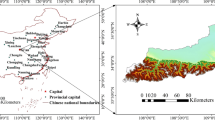Abstract
Urban development and climate change have led to severe waterlogging in cities. To study the degree of mitigation of urban waterlogging using the design of sponge city roads, this study employed No. 9 Road in the Sino-German Eco-park. By establishing the scaled physical model, the pavement structure of the sponge city road was optimized. Furthermore, water migration (seepage, impoundment, and drainage) rule was obtained under different rainfall intensities using the optimal pavement scheme. The following conclusions were drawn from the studies. Good permeability of the sidewalk surface structure is conducive for rainwater collection. The sponge urban road rainwater collection and utilization system could absorb up to 88% of rainwater under the rainfall intensity of 173 mm (extra heavy rain), and could absorb up to 100% of rainwater under heavy rain conditions. The seepage volume increased exponentially with the rise in rainfall intensity, and the amount of water storage increased linearly with the rainfall intensity. These results can provide guidance for safety early warning of urban waterlogging on No. 9 Road in the Sino-German Eco-park and deeper insights in the design of sponge city roads.












Similar content being viewed by others
Data availability
The data used to support the findings of this study are included within the article.
References
Ahiablame, L. M., Engel, B. A., & Chaubey, I. (2012). Effectiveness of low impact development practices: Literature review and suggestions for future research. Water, Air, & Soil Pollution, 223(7), 4253–4273.
Braswell, A. S., Winston, R. J., & Hunt, W. F. (2018). Hydrologic and water quality performance of permeable pavement with internal water storage over a clay soil in Durham, North Carolina. Journal of Environmental Management, 224, 277–287.
China Meteorological Date Service Center (CMDC). (2019). Climate data set of China ground international exchange station. National Meteorological Information Center. (in Chinese).
Chinese Ministry of Housing and Urban Rural Development (MHURD). Preliminary Technical Guidance for Sponge City Construction—Low Impact Development Rainwater System Construction; MHURD: Beijing, China, 2014; (in Chinese).
Debo, T. N., & Reese, A. (2010). Municipal stormwater management (2nd ed.). Taylor and Francis.
Fotovatikhah, F., Herrera, M., Shamshirband, S., et al. (2018). Survey of computational intelligence as basis to big flood management: Challenges, research directions and future work. Engineering Applications of Computational Fluid Mechanics, 12(1), 411–437.
Guomin, J., Xunpeng, Y., Ke, L. (2020). The causes and countermeasures of urban waterlogging. Construction & Design for Engineering, 2020(05), 85–86+89. https://doi.org/10.13616/j.cnki.gcjsysj.2020.03.030.
Hu, M., Zhang, X., Siu, Y. L., et al. (2018). Flood mitigation by permeable pavements in Chinese sponge city construction. Water, 10(2), 172.
Jiang, Y., Zevenbergen, C., & Ma, Y. (2018). Urban pluvial flooding and stormwater management: A contemporary review of China’s challenges and “sponge cities” strategy. Environmental Science & Policy, 80, 132–143.
Kuruppu, U., Rahman, A., & Rahman, M. A. (2019). Permeable pavement as a stormwater best management practice: A review and discussion. Environmental Earth Sciences, 78(10), 327.
Li, W. T., Yang, N., Mei, Y. C., et al. (2019). Experimental investigation of the compression-bending property of the casing joints in a concrete filled steel tubular supporting arch for tunnel engineering. Tunnelling and Underground Space Technology, 96, 103184.
Mai, T., Mushtaq, S., Reardon-Smith, K., et al. (2020). Defining flood risk management strategies: A systems approach. International Journal of Disaster Risk Reduction., 47, 101550.
Nguyen, T. T., Ngo, H. H., Guo, W., et al. (2019). Implementation of a specific urban water management-Sponge City. Science of the Total Environment, 652, 147–162.
Peng, Q., Greenfield, B. K., Dang, F., & Zhong, H. (2016). Human exposure to methylmercury from crayfish (Procambarus clarkii) in China. Environmental Geochemistry and Health, 38(1), 169–181.
Peng, Z., Jinyan, K., Wenbin, P., et al. (2019). Effects of low-impact development on urban rainfall runoff under different rainfall characteristics. Polish Journal of Environmental Studies, 28(2), 771–783.
Saaly, M., Hedayat, M. M., & Golroo, A. (2019). Performance of pervious concrete pavement under various raining conditions. Road Materials and Pavement Design, 20(7), 1653–1663.
Sang, Y. F., & Yang, M. (2017). Urban waterlogs control in China: More effective strategies and actions are needed. Natural Hazards, 85(2), 1291–1294.
State Ministry of Housing Construction, China Meteorological Administration. (2014). Technical Guidelines for Establishment of Intensity-Duration-Frequency Curve and Design Rainstorm Profile.
Sun, P. P., Yang, X. X., Sun, D. K., et al. (2019). Geometric and mechanical properties of a shear-formed fracture occurring in a rock bridge between discontinuous joints. Bulletin of Engineering Geology and the Environment, 79(3), 1365–1380.
Sun, S., Zhai, J., Li, Y., Huang, D., & Wang, G. (2020). Urban waterlogging risk assessment in well-developed region of Eastern China. Physics and Chemistry of the Earth, Parts a/b/c, 115, 102824.
Wang, H. W., Zhai, Y. J., Wei, Y. Y., & Mao, Y. F. (2019a). Evaluation of the effects of low-impact development practices under different rainy types: Case of Fuxing Island Park, Shanghai, China. Environmental Science and Pollution Research, 26(7), 6706–6716.
Wang, J., Li, S. C., Li, L. P., et al. (2019b). Attribute recognition model for risk assessment of water inrush. Bulletin of Engineering Geology and the Environment, 78(2), 1057–1071.
Zejun, H. (2012). Problems and countermeasures of city waterlogging disaster. Water Sciences and Engineering Technology, 2012(01), 7–10. https://doi.org/10.19733/j.cnki.1672-9900.2012.01.003.
Zhang, X., Hu, M., Chen, G., & Xu, Y. (2012). Urban rainwater utilization and its role in mitigating urban waterlogging problems—a case study in Nanjing, China. Water Resources Management, 26(13), 3757–3766.
Acknowledgements
This study is supported by National Natural Science Foundation of China [Grant Number 51909149]; Science and Technology Project of Shandong Housing and Urban Rural Development Department [Grant Number2019-s7-1]; and Shandong Key Laboratory of Civil Engineering Disaster Prevention and Mitigation [Grant Number CDPM2019ZR10].
Author information
Authors and Affiliations
Corresponding author
Additional information
Publisher's Note
Springer Nature remains neutral with regard to jurisdictional claims in published maps and institutional affiliations.
Rights and permissions
About this article
Cite this article
Qin, Z., Yao, Y., Zhao, J. et al. Investigation of migration rule of rainwater for sponge city roads under different rainfall intensities. Environ Geochem Health 44, 3395–3407 (2022). https://doi.org/10.1007/s10653-021-01104-9
Received:
Accepted:
Published:
Issue Date:
DOI: https://doi.org/10.1007/s10653-021-01104-9




